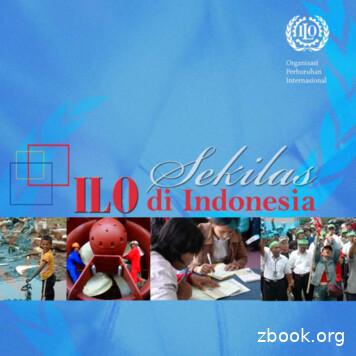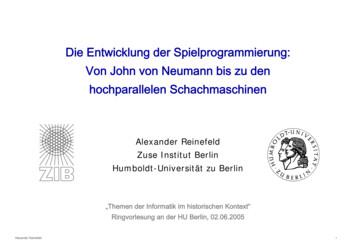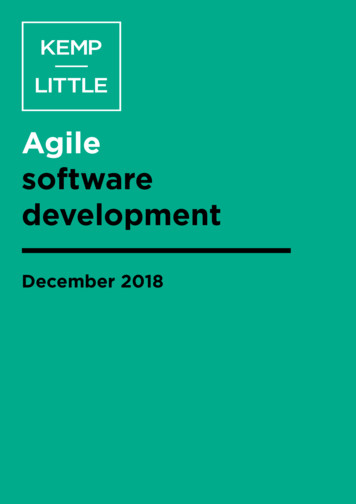ILO Ilo /ipec/lang--en/index.htm Sirti Oit@ilo .
Child and adolescent labour in Latin America and the CaribbeanCHILD LABOUR RISKIDENTIFICATIONMODELMETHODOLOGY TO DESIGNPREVENTIVE STRATEGIESAT LOCAL LEVEL1
Copyright International Labour Organization 2018First published 2018Publications of the International Labour Office enjoy copyright under Protocol 2 of the Universal Copyright Convention.Nevertheless, short excerpts from them may be reproduced without authorization, on condition that the source is indicated.For rights of reproduction or translation, application should be made to ILO Publications (Rights and Licensing), InternationalLabour Office, CH-1211 Geneva 22, Switzerland, or by email: rights@ilo.org. The International Labour Office welcomes suchapplications.Libraries, institutions and other users registered with a reproduction rights organization may make copies in accordancewith the licences issued to them for this purpose. Visit www.ifrro.org to find the reproduction rights organization in yourcountry.ILO-ECLACChild Labour Risk Identification Model: Methodology to design preventive strategies at local level.Lima: ILO/ECLAC, 2018. 104 p.child labour / policy / Latin America / CaribbeanISBN: 978-92-2-132061-6 (print)ISBN: 978-92-2-132062-3 (web pdf)13.01.2ILO Cataloguing in Publication DataThe designations employed in ILO publications, which are in conformity with United Nations practice, and the presentationof material therein do not imply the expression of any opinion whatsoever on the part of the International Labour Officeconcerning the legal status of any country, area or territory or of its authorities, or concerning the delimitation of its frontiers.The responsibility for opinions expressed in signed articles, studies and other contributions rests solely with their authors,and publication does not constitute an endorsement by the International Labour Office of the opinions expressed in them.Reference to names of firms and commercial products and processes does not imply their endorsement by the InternationalLabour Office, and any failure to mention a particular firm, commercial product or process is not a sign of disapproval.ILO publications and digital products can be obtained through major booksellers and digital distribution platforms, orordered directly from ilo@turpin-distribution.com. For more information, visit our website: www.ilo.org/publns or contactilopubs@ilo.org.Printed in Lima
AcknowledgementsThis document is a result of the Project ILO-ECLAC on “Child labour, poverty and inequality”, an interagency action promoted by the International Labour Organization (ILO), in its capacity of TechnicalSecretariat of the Regional Initiative Latin America and the Caribbean Free of Child Labour. This jointaction seeks to generate knowledge to improve political decision making on the prevention and thesustained eradication of child labour in the region.The report was prepared by Andres Espejo, Officer of the Social Development Division of the EconomicCommission for Latin America and the Caribbean (ECLAC), under the supervision of Lais Abramo,Director of the Social Development Division, and Daniela Trucco, Social Affairs Officer.We are grateful to Heidi Ullmann, Claudia Robles, Veronica Amarante, Soledad Villafane and PabloVillatoro, of the ECLAC team, and Elena Montobbio, Maria Olave, Noortje Denkers and Olga Gomez, ofthe Child Labour Team at the Regional Office of the ILO for Latin America, for their valuable commentson previous versions of this document. Likewise, we thank the contributions received from FurioRosati of the project Understanding Children's Work (UCW), Valentina Cortinez of RIMISP – LatinAmerican Center for Rural Development, and Jose Maria Ramirez of the Fundamental Principles andRights at Work (Fundamentals) of the ILO in Geneva. Finally, special thanks to Ernesto Espindola,one of the precursors of the model developed in this document, who also provided useful commentsduring the work performed.
2INDEXFactorsassociatedwith childlabour context2.1 Factors associatedwith the contextFOREWORDINTRODUCTION61Child andadolescent labourin Latin Americaand the Caribbean 14A. MacroeconomiccontextB. Economic sectors andlocal labour marketC. InstitutionsD. Public policies2.2 Factors associatedwith familyand individualcharacteristics10A. Poverty andvulnerabilityB. Family and householdcharacteristicsC. Characteristics of thechild or adolescent5Example ofimplementationand validation ofthe methodology 6846Conclusions202222242533393941443Measurement ofchild labour andits information46sources3.1 Statistical definitionof child labour473.2 Informationsources50A. Surveys and/ormodules that allowmeasuring childlabourB. Population andhousing censusesC. 100Annex 1:Studies on childlabour related factors10154ChildLabour RiskIdentificationModel584.1 Stage I: Identificationof child labour relatedfactors604.2 Stage II: Elaborationof the logisticmodel614.3 Stage III:Implementationof the modelthrough populationcensuses644.4 Stage IV: Territorialcharacterization65
Child Labour Risk Identification ModelFOREWORD6
Child and adolescent labour in Latin America and the CaribbeanThis publication is a result of the excellent collaboration between the Economic Commission for LatinAmerica and the Caribbean (ECLAC) and the Regional Office for Latin America and the Caribbean ofthe International Labour Organization (ILO). On this occasion, the issue of child labour is addressed.In recent years, Latin America and the Caribbean has reduced child labour thanks to the sustainedaction and shared efforts among governments, employers' and workers' organizations, civil societyand international cooperation agencies. Between 2012 and 2016, the region showed a reduction of17% in the rate of child labour and 35% in the rate of hazardous child labour. In other words, twomillion children and adolescents stopped working in our countries during this period.Despite the good news, the countries of the region should not lower their guard because there arestill 10.5 million children and adolescents between the ages of 5 and 17 who work, most of them inhazardous activities that prevent them from completing their education, put their health and safetyat serious risk and limit the development of skills to insert properly in the labour market. Specialattention must be paid to those who are most at risk of entering the workplace early: children andadolescents vulnerable due to economic deprivation in the houdehold, poor levels of social protection,inequality and belonging to groups particularly exposed to child labour and its worst forms, such asindigenous peoples, rural populations, the Afro-descendant population, migrants, women and girls,and those who reside in areas at risk of disasters.Although the goal of prevention and eradication of child labour has been present, with different levelsof priority, in the political agenda of most countries in the region, the adoption of the 2030 Agendafor Sustainable Development, in September 2015, gave new impetus and vigor to this struggle, byincluding in SDG 8 on decent work and economic growth, Target 8.7, which calls to "Take immediateand effective measures to eradicate forced labour, end modern slavery and human trafficking andsecure the prohibition and elimination of the worst forms of child labour, including recruitment anduse of child soldiers, and by 2025 end child labour in all its forms."The complexity of the phenomenon, combined with an uncertain economic scenario for Latin Americaand the Caribbean, calls on governments, employers' and workers', civil society organizations andinternational agencies, not only to redouble efforts to avoid a setback, but to define more focused,coordinated and integrated strategies to deal with the persistence of child labour, especially in itsworst forms. Moving towards the achievement of Target 8.7 implies not only reducing child labour,but also achieving at least 35 other targets established in the SDGs1, which have strong links andinterdependencies on issues that are crucial to the development agenda of the region.1See: http://target8-7.iniciativa2025alc.org/en/7
Child Labour Risk Identification ModelNot leaving anyone behind in achieving these Sustainable Development Goals requires looking forimaginative ways to cooperate between countries and stakeholders, putting value on knowledge,experience and accumulated capacity. Along these lines, 28 countries in the region2, with theparticipation of employers' and workers' organizations, created the Regional Initiative Latin Americaand the Caribbean Free of Child Labour, a platform that seeks to accompany the first generation freeof child labour for the year 2025.The Regional Initiative proposes a Policy Acceleration Framework that includes strategies thatreinforce the social protection and education systems focused on the prevention and eradication ofchild labour, coordinating the intervention with the Ministries or Secretaries of Labour. This frameworkis based on two areas of intervention: 1) protection to remove children and adolescents from childlabour and the restoration of their rights; and 2) prevention through actions designed to identify andintervene in a timely manner to interrupt the trajectory of child labour.The present study, which is part of the second area, seeks to provide empirical evidence that servesas a basis to establish priorities in national and subnational policies aimed at the prevention andelimination of child labour. To this end, the ILO Regional Office for Latin America and the Caribbeanand ECLAC jointly developed the Child Labour Risk Identification Model, a methodology that, based onthe statistical information available in the countries (surveys, censuses and/or administrative records)allows, on the one hand, to identify the territories most vulnerable to child labour and, on the other, toestimate the weight of various factors associated in order to determine which multisectoral actionsare more effective in interrupting the trajectory of child labour and, in the medium term, reduce theindicator in a sustained manner.This technical document was submitted, between August 2016 and March 2017, to a validation processwith experts from the Brazilian Cooperation Agency (ABC); the Spanish Agency for InternationalDevelopment Cooperation (AECID); the United States Department of Labor (USDOL); the IberoAmerican Federation of Ombudsmen (FIO) - GIZ Project; the Pan American Health Organization(PAHO); the Understanding Children's Work Programme (UCW); and ILO and ECLAC specialists andstatisticians.In April 2017, the pilot process of applying the Model began in a group of countries that expressed theirinterest in participating and that met a set of basic criteria, identified by the ILO and ECLAC, whichguaranteed the viability of the process. Thus, the participation of Argentina, Brazil, Colombia, CostaRica, Jamaica, Mexico and Peru was formalized. These countries have followed an implementationpath that has been adapted to the particularity of their political and institutional context and in whichtools and processes of technical assistance have been adapted, and different levels of dialogue andinter-institutional coordination have been applied.2The 28 countries are: Argentina, Bahamas, Barbados, Bolivia, Brazil, Chile, Colombia, Costa Rica, Cuba, DominicanRepublic, Ecuador, El Salvador, Grenada, Guatemala, Guyana, Haiti, Honduras, Jamaica, Mexico, Nicaragua, Panama,Paraguay, Peru, Saint Lucia, Suriname, Trinidad & Tobago, Uruguay and Venezuela.8
ForewordThe inter-agency work of ILO and ECLAC in the measurement and characterization of child andadolescent labour in Latin America and the Caribbean is expected to be a contribution, in particular,to the Ministries of Labour and Social Development, as well as the National Statistics Institutions ofthe countries of the region, so they undertake similar studies and periodic measurements that serveas an input to adjust and focus their preventive actions in the territories with the highest risk of childlabour.Having a tool to analyze and monitor the evolution of child and adolescent labour at the local levelis a way to territorialize the 2030 Agenda, while allowing countries to advance in the achievement ofnational goals and meet the commitments at the international level to ensure that children enjoy theirchildhood, are able to exercise their rights and access the same opportunities to expand their talentand develop their skills.José Manuel Salazar-XirinachsRegional Director for Latin America and the CaribbeanInternational Labour Organization(ILO)Alicia BárcenaExecutive Secretary of the Economic Commissionfor Latin America and the Caribbean(ECLAC)9
Child Labour Risk Identification ModelINTRODUCTION10
Child and adolescent labour in Latin America and the CaribbeanChild labour is a broad and persistent phenomenon in Latin America and the Caribbean. Its occurrenceis directly linked to the violation of the fundamental rights of boys, girls and adolescents since itgenerates profound and lasting negative impacts throughout life (ECLAC, 2017). Over the last 20 years,in recognition of these profound negative consequences, the countries in the region have been makinggreat efforts to eradicate this scourge. These include the ratification of international instruments-especially the ILO Minimum Age Convention, 1973 (No. 138) and the ILO Convention on the WorstForms of Child Labour, 1999 (No. 182), the achievement of important advances in legislative mattersnationwide, the development of a knowledge base on the topic and the promotion of prevention anderadication policies and programmes. This led to a significant reduction of child labour incidence3,placing Latin America and the Caribbean in a privileged position to become the first developing regionfree of child labour (ILO, 2013).According to estimates of the International Labour Organization (ILO, 2017), nearly 10.5 million boys,girls and adolescents are in child labour in Latin America and the Caribbean, corresponding to 7.3%of the regional population between 5 and 17 years. Although a downward trend can be observed whencomparing this with the estimates of 2008, it is also verifiable that the progress is slow despite theimprovements within the region in terms of productivity and reduction of poverty and inequality.The complexity of the phenomenon combined with a diverse economic scenario for Latin America4calls for redoubling efforts to avoid a setback. In this context, 28 countries of the region, and employersand workers' organizations, came together to create the Regional Initiative Latin America and theCaribbean Free of Child Labour, that seeks to accelerate the rate of decline of child labour and toachieve its full elimination by 2025, in response to the Global Road Map, the goals of the HemisphericAgenda on Decent Work and the Sustainable Development Goals (SDGs), that position once more theeradication of child labour as a priority goal under Target 8.7.In order to achieve the ambitious goal to eliminate all forms of child labour by 2025, the RegionalInitiative has developed a Policy Acceleration Framework5. This includes a series of strategies thatseek to maximize the scope and effectiveness of the social protection and education systems inthe prevention and eradication of child labour, under the articulation of the respective Ministriesof Labour (ILO, 2017). The Policy Acceleration Framework is based on the combination of twoapproaches: on one hand, the protection approach for the rescue from child labour and therestoration of rights, and on the other hand, a preventive approach that includes actions aimed345“It is likely that this progress has also been largely driven by broader economic and demographic forces thataccompanied government efforts” (ILO, 2017:3).See: ECLAC. (2017). Gaps, axes and challenges in the link between social and productive areas.See: cceleration-framework.pdf11
Child Labour Risk Identification Modelat identifying and timely intervening boys and girls in child labour trajectory to prevent their earlyentry into the labour market.It is imperative to provide reliable, comprehensive and timely data as the basis to determinepriorities of national and sub-national action aimed at the prevention and elimination of childlabour. Therefore, the Regional Office of the ILO for the Americas, in its capacity of TechnicalSecretariat of the Regional Initiative Latin America and the Caribbean Free of Child Labour,requested technical assistance to the Economic Commission for Latin America and the Caribbean(ECLAC) in order to jointly elaborate an instrument that enables the timely identification of boys,girls and adolescents in the trajectory of child labour.This instrument, called Child Labour Risk Identification Model, allows to identify territorieswhere there is greater likelihood of child labour based on existing statistical information in thecountries, and it also allows to estimate the weight of several risk indicators in the territories,in order to define the most relevant multi-sectoral actions needed to interrupt the trajectory ofchild labour. This provides the countries with reliable information at national and sub-nationallevel and enables them to design focused and articulated responses, to improve the performanceand effectiveness of public policies and to advance in the achievement of national goals and thuscontribute to the achievement of global commitments assumed.The document has five sections. The first one examines the current context of child labour inthe region based on available information, analyses its prevalence in the countries and seekscommon characteristics among them. The second section reviews several studies and conductsan analysis that identifies the factors that relate to child labour. This section is split in two parts.On one hand, it analyzes the factors related to the context and on the other hand, it providesevidence about household related factors and those related to boys and girls. The third sectionreviews the measurement of child labour, in particular the statistical definition and availablesources of information. The fourth section proposes a methodology to identify and estimate therisk of child labour at sub-national level based on available statistical information. Finally, thefifth section presents a validation exercise of the proposed methodology, showing its strengthsand weaknesses.12
Child Labour Risk Identification Model1CHILDAND ADOLESCENTLABOUR IN LATINAMERICA ANDTHE CARIBBEAN14
Child and adolescent labour in Latin America and the CaribbeanMost countries in Latin America and the Caribbean have made major efforts to prevent and eliminatechild labour. As a result, the incidence of child labour has sharply declined in both absolute andrelative terms, placing the region in a privileged position to become the first developing region free ofchild labour (ILO, 2013).According to ILO estimates (2017), the percentage of children and adolescents aged 5 to 17 in thelabour market declined from 10.8% in 2008 to 7.3% in 2016, meaning that 3.7 million fewer childrenworked in the region. During this period, hazardous child labour6 also experienced a significantreduction from 6.7% to 4.4%, equivalent to 3.2 million children and adolescents.Table 1Latin America and the Caribbean: Child labour and hazardous child labour, 5 to 17 years,2008, 2012 and 2016PercentagePopulationin hazardouschild n inchild labour5-172008141.043.00020122016Source: ILO, 2013 and ILO, 2017.In absolute numbers, more than 10.4 million children and adolescents -aged 5 to 17- were involvedin child labour in the region in 2016. Although the statistics are not
For rights of reproduction or translation, application should be made to ILO Publications (Rights and Licensing), International Labour Office, CH-1211 Geneva 22, Switzerland, or by email: rights@ilo.org. The International Labour Office welcomes such applications.
a founding member of the International Pharmaceutical Excipients Council (IPEC) Americas and participates on all committees, including the IPEC Americas Executive Committee, Compendial Review, Excipient Qualification, Regulatory Affairs and Excipient Composition. We are also active participants in IPEC Europe and founding members of IPEC China.
Audit Guideline is intended only to cover aspects of GMP relating to excipient manufacture. For auditing of repackagers or distributors, see the IPEC Good Distribution Practices Audit Guideline for Pharmaceutical Excipients. II. Content and Usage The Joint IPEC-PQG "Good Manufacturing Practices Guide for Pharmaceutical Excipients" 2006 was used
Sekilas ILO di Indonesia Indonesia dan ILO telah menjalin kerja sama sejak Indonesia menjadi anggota ILO pada 12 Juni 1950. Menerapkan struktur tripartit yang unik, ILO membangun kerja . pelatih tentang isu migrasi kerja di kantong-kantong tenaga kerja di Indonesia, serta (v) riset, dokumentasi dan publikasi. 8 Yang kami lakukan: 9
productive working relationship - ILO white paper / International Labour Organization, Regional Office for Arab States. - Beirut: ILO, 2017. ISBN 9789221302513 (print) ISBN 9789221302544 (web pdf) ILO Regional Office for Arab States ILO Cataloguing in Publication Data
World Microcomputer Chess Champions (WMCCC) 1 1980 London Chess Challenger Spracklen USA 2 1981 Travemünde Fidelity X Spracklen USA 3 1983 Budapest Elite A/S Spracklen USA 4 1984 Glasgow Elite X Spracklen USA 5 1985 Amsterdam Mephisto Lang UK 6 1986 Dallas Mephisto Lang UK 7 1987 Rome Mephisto Lang UK 8 1988 Almeria Mephisto Lang UK
Serge Lang, 1927–2005 Jay Jorgenson and Steven G. Krantz 536 NOTICESOFTHEAMS VOLUME53, NUMBER5 O n September 12, 2005, the mathemat-ics community lost Serge Lang, who passed away in his apartment in Berke-ley, California. Lang was well known as a mathematician, and also as an edu-cator and political activist. The main force in Serge’s
Jessica Lang Dance Founded in 2011, Jessica Lang Dance is dedicated to creating and performing the work of Jessica Lang. JLD has been presented in world renowned venues including the John F. Kennedy Center for the Performing Arts, the Harris Theater for Music and Dance, Palacio
Agile software development therefore has a focus on: . Scrum is one of the most popular agile development methodologies. Scrum is a lightweight framework designed to help small, close-knit teams of people to create complex software products. The key features of the scrum methodology are as follows: Scrum team: A team of people using this methodology are called a “scrum”. Scrums usually .























